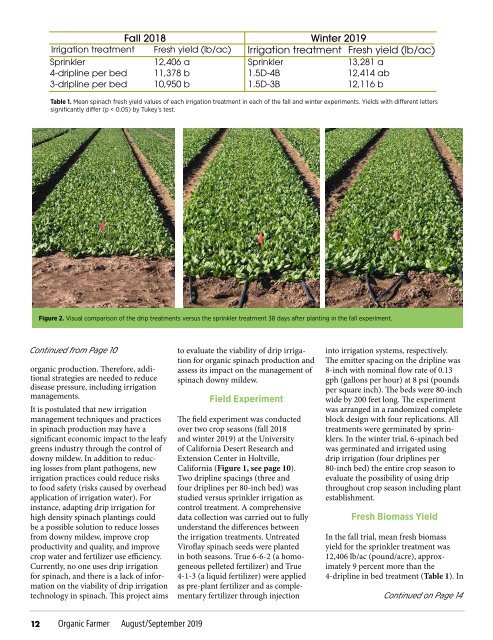Organic Farmer Aug/Sept 2019
- No tags were found...
Create successful ePaper yourself
Turn your PDF publications into a flip-book with our unique Google optimized e-Paper software.
Irrigation treatment<br />
Sprinkler<br />
4-dripline per bed<br />
3-dripline per bed<br />
Fall 2018<br />
Fresh yield (lb/ac)<br />
12,406 a<br />
11,378 b<br />
10,950 b<br />
Winter <strong>2019</strong><br />
Irrigation treatment Fresh yield (lb/ac)<br />
Sprinkler<br />
1.5D-4B<br />
1.5D-3B<br />
13,281 a<br />
12,414 ab<br />
12,116 b<br />
Table 1. Mean spinach fresh yield values of each irrigation treatment in each of the fall and winter experiments. Yields with different letters<br />
significantly differ (p < 0.05) by Tukey’s test.<br />
Figure 2. Visual comparison of the drip treatments versus the sprinkler treatment 38 days after planting in the fall experiment.<br />
Continued from Page 10<br />
organic production. Therefore, additional<br />
strategies are needed to reduce<br />
disease pressure, including irrigation<br />
managements.<br />
It is postulated that new irrigation<br />
management techniques and practices<br />
in spinach production may have a<br />
significant economic impact to the leafy<br />
greens industry through the control of<br />
downy mildew. In addition to reducing<br />
losses from plant pathogens, new<br />
irrigation practices could reduce risks<br />
to food safety (risks caused by overhead<br />
application of irrigation water). For<br />
instance, adapting drip irrigation for<br />
high density spinach plantings could<br />
be a possible solution to reduce losses<br />
from downy mildew, improve crop<br />
productivity and quality, and improve<br />
crop water and fertilizer use efficiency.<br />
Currently, no one uses drip irrigation<br />
for spinach, and there is a lack of information<br />
on the viability of drip irrigation<br />
technology in spinach. This project aims<br />
to evaluate the viability of drip irrigation<br />
for organic spinach production and<br />
assess its impact on the management of<br />
spinach downy mildew.<br />
Field Experiment<br />
The field experiment was conducted<br />
over two crop seasons (fall 2018<br />
and winter <strong>2019</strong>) at the University<br />
of California Desert Research and<br />
Extension Center in Holtville,<br />
California (Figure 1, see page 10).<br />
Two dripline spacings (three and<br />
four driplines per 80-inch bed) was<br />
studied versus sprinkler irrigation as<br />
control treatment. A comprehensive<br />
data collection was carried out to fully<br />
understand the differences between<br />
the irrigation treatments. Untreated<br />
Viroflay spinach seeds were planted<br />
in both seasons. True 6-6-2 (a homogeneous<br />
pelleted fertilizer) and True<br />
4-1-3 (a liquid fertilizer) were applied<br />
as pre-plant fertilizer and as complementary<br />
fertilizer through injection<br />
into irrigation systems, respectively.<br />
The emitter spacing on the dripline was<br />
8-inch with nominal flow rate of 0.13<br />
gph (gallons per hour) at 8 psi (pounds<br />
per square inch). The beds were 80-inch<br />
wide by 200 feet long. The experiment<br />
was arranged in a randomized complete<br />
block design with four replications. All<br />
treatments were germinated by sprinklers.<br />
In the winter trial, 6-spinach bed<br />
was germinated and irrigated using<br />
drip irrigation (four driplines per<br />
80-inch bed) the entire crop season to<br />
evaluate the possibility of using drip<br />
throughout crop season including plant<br />
establishment.<br />
Fresh Biomass Yield<br />
In the fall trial, mean fresh biomass<br />
yield for the sprinkler treatment was<br />
12,406 lb/ac (pound/acre), approximately<br />
9 percent more than the<br />
4-dripline in bed treatment (Table 1). In<br />
Continued on Page 14<br />
12<br />
<strong>Organic</strong> <strong>Farmer</strong> <strong>Aug</strong>ust/<strong>Sept</strong>ember <strong>2019</strong>


















